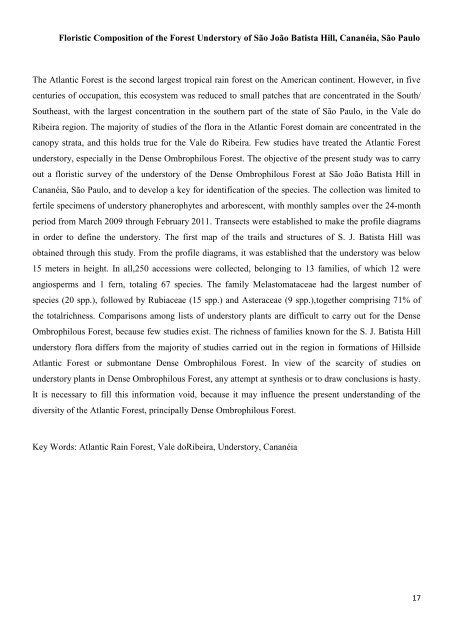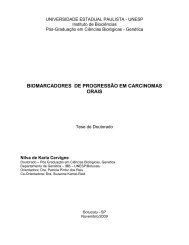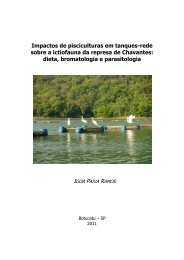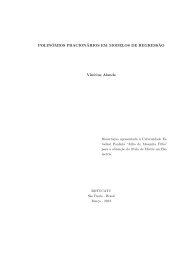Visualizar Tese - Instituto de Biociências - Unesp
Visualizar Tese - Instituto de Biociências - Unesp
Visualizar Tese - Instituto de Biociências - Unesp
Create successful ePaper yourself
Turn your PDF publications into a flip-book with our unique Google optimized e-Paper software.
Floristic Composition of the Forest Un<strong>de</strong>rstory of São João Batista Hill, Cananéia, São PauloThe Atlantic Forest is the second largest tropical rain forest on the American continent. However, in fivecenturies of occupation, this ecosystem was reduced to small patches that are concentrated in the South/Southeast, with the largest concentration in the southern part of the state of São Paulo, in the Vale doRibeira region. The majority of studies of the flora in the Atlantic Forest domain are concentrated in thecanopy strata, and this holds true for the Vale do Ribeira. Few studies have treated the Atlantic Forestun<strong>de</strong>rstory, especially in the Dense Ombrophilous Forest. The objective of the present study was to carryout a floristic survey of the un<strong>de</strong>rstory of the Dense Ombrophilous Forest at São João Batista Hill inCananéia, São Paulo, and to <strong>de</strong>velop a key for i<strong>de</strong>ntification of the species. The collection was limited tofertile specimens of un<strong>de</strong>rstory phanerophytes and arborescent, with monthly samples over the 24-monthperiod from March 2009 through February 2011. Transects were established to make the profile diagramsin or<strong>de</strong>r to <strong>de</strong>fine the un<strong>de</strong>rstory. The first map of the trails and structures of S. J. Batista Hill wasobtained through this study. From the profile diagrams, it was established that the un<strong>de</strong>rstory was below15 meters in height. In all,250 accessions were collected, belonging to 13 families, of which 12 wereangiosperms and 1 fern, totaling 67 species. The family Melastomataceae had the largest number ofspecies (20 spp.), followed by Rubiaceae (15 spp.) and Asteraceae (9 spp.),together comprising 71% ofthe totalrichness. Comparisons among lists of un<strong>de</strong>rstory plants are difficult to carry out for the DenseOmbrophilous Forest, because few studies exist. The richness of families known for the S. J. Batista Hillun<strong>de</strong>rstory flora differs from the majority of studies carried out in the region in formations of Hillsi<strong>de</strong>Atlantic Forest or submontane Dense Ombrophilous Forest. In view of the scarcity of studies onun<strong>de</strong>rstory plants in Dense Ombrophilous Forest, any attempt at synthesis or to draw conclusions is hasty.It is necessary to fill this information void, because it may influence the present un<strong>de</strong>rstanding of thediversity of the Atlantic Forest, principally Dense Ombrophilous Forest.Key Words: Atlantic Rain Forest, Vale doRibeira, Un<strong>de</strong>rstory, Cananéia17
















